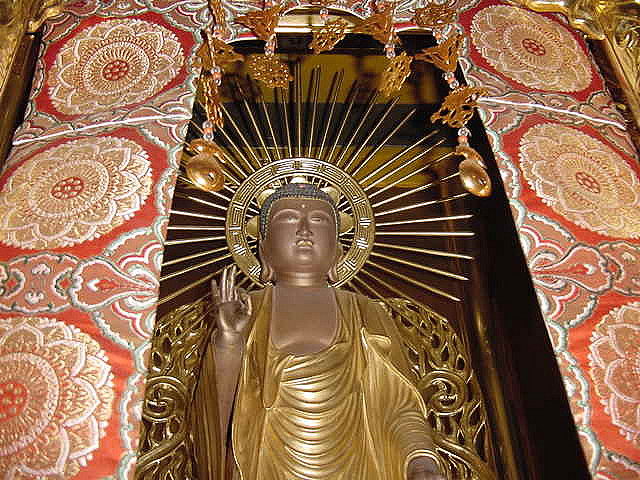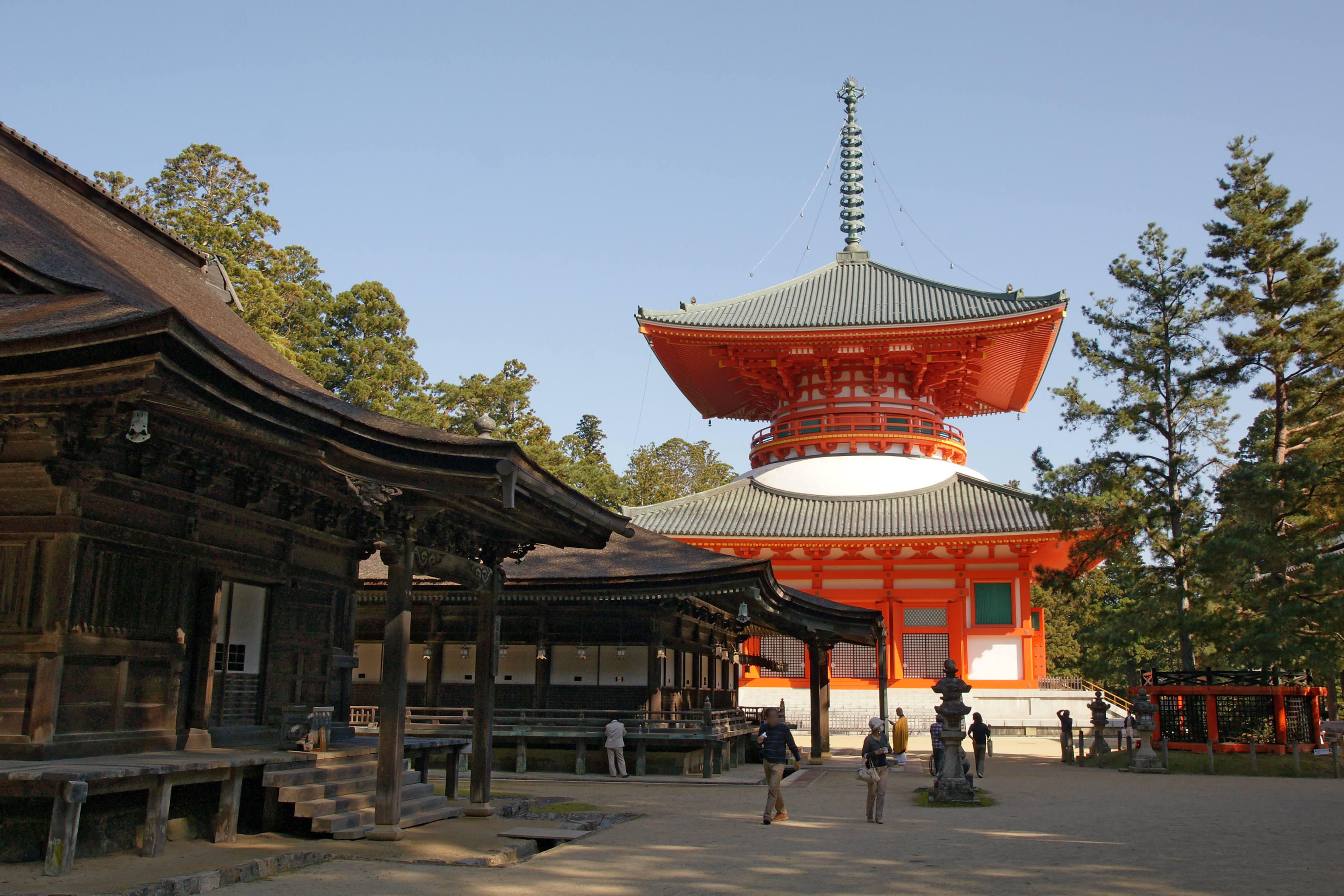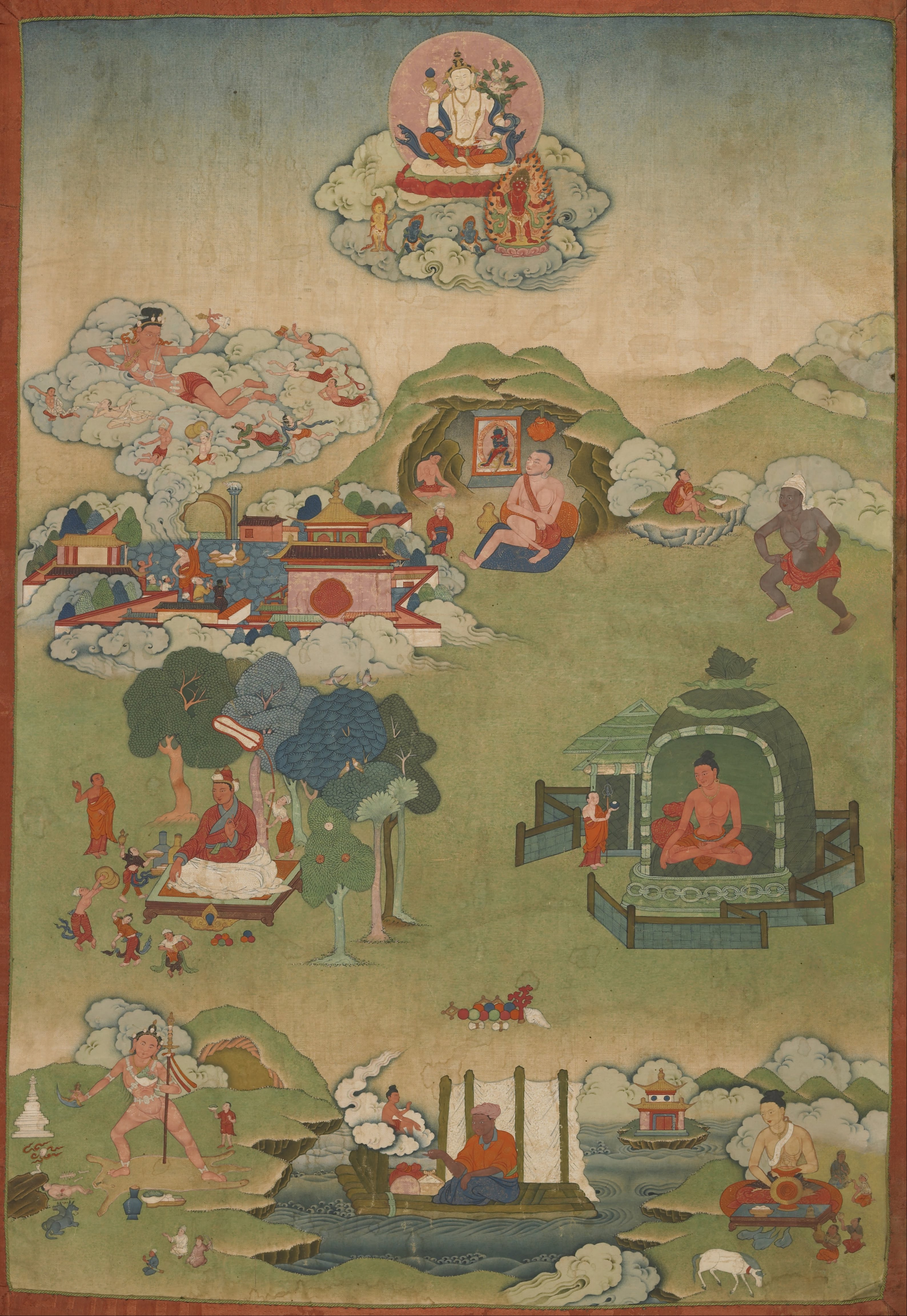|
Honzon
, sometimes referred to as a Gohonzon ( or ), is the enshrined main image or principal deity in Japanese Buddhism. The buddha, bodhisattva, or mandala image is located in either a temple or a household butsudan. The image can be either a statue or a small scroll and varies from sect to sect. It can be a singular image or a group of images; the ''honzon'' in the main (''hondō'') or treasure (''kondō'') hall of the temple can be for that particular hall or the entire temple complex. Sometimes ''honzon'' is the central image (''chūson'') of a cluster of three (''sanzonbutsu'') or five (''goson'') images. The physical creation of an icon is followed by a consecration ceremony (known as ''kaigen'', literally 'opening the eyes' or 'dotting the eyes'). It is believed this transforms the ''honzon'' into a 'vessel' of the deity which in its own right has power. Butsuzō A honzon that takes the form of a statue is called a ''Butsuzō'' () or ''Honzonbutsu'' (), most likely crafte ... [...More Info...] [...Related Items...] OR: [Wikipedia] [Google] [Baidu] |
Yidam
A ''yidam'' or ''iṣṭadevatā'' is a meditational deity that serves as a focus for meditation and spiritual practice, said to be manifestations of Buddhahood or enlightened mind. Yidams are an integral part of Vajrayana, including Tibetan Buddhism, Chinese Esoteric Buddhism and Shingon, which emphasize the use of esoteric practices and rituals to attain enlightenment more swiftly. The yidam is one of the three roots of the inner refuge formula and is also the key element of deity yoga. Yidam is sometimes translated by the term "tutelary deity". A yidam is considered to be a manifestation of enlightened qualities and a means to connect with specific aspects of the enlightened mind. The yidam is visualized during meditation in intricate detail, with the aim of internalizing its qualities and attributes. This practice is intended to facilitate the practitioner's transformation and realization of their own innate enlightened nature. It is believed to help purify the mind, ... [...More Info...] [...Related Items...] OR: [Wikipedia] [Google] [Baidu] |
Gohonzon
is a generic term for a venerated religious object in Japanese Buddhism. It may take the form of a scroll or statuary. The term typically refers to the mainstream use of venerated objects within Nichiren Buddhism, referring to the calligraphic paper mandala inscribed by the 13th Japanese Buddhist priest Nichiren to which devotional chanting is directed. Linguistically, the root word derives from ancient word , signifying a devotional object of respect or worship, and with the honorific prefix. Varying Nichiren groups accord their own meanings to the term in different ways, signifying their treatment of the object: * "Object of Devotion" — Soka Gakkai * "Object of Worship" — Nichiren Shōshū * "The Great Mandala, Venerated Supreme" — Nichiren-shū sects Paper scroll are sometimes known as or . The term is used for statuary. are often enshrined within an altar shrine (). Description Nichiren himself attached the greatest importance to his inscription of ... [...More Info...] [...Related Items...] OR: [Wikipedia] [Google] [Baidu] |
Shingon
is one of the major schools of Buddhism in Japan and one of the few surviving Vajrayana lineages in East Asian Buddhism. It is a form of Japanese Esoteric Buddhism and is sometimes called "Tōmitsu" (東密 lit. "Esoteric [Buddhism] of Tō-ji"). The word ''shingon'' is the Kan-on, Japanese reading of the Traditional Chinese characters, Chinese word ('), which is the translation of the Sanskrit word mantra. The Chinese Esoteric Buddhism, Zhēnyán lineage was founded in China (c. 7th–8th centuries) by Indian Vajracharya, vajrācāryas (esoteric masters) like Śubhakarasiṃha, Vajrabodhi and Amoghavajra. These esoteric teachings would later flourish in Japan under the auspices of a Buddhist monk named Kūkai (, 774–835), who traveled to Tang dynasty, Tang China and received these esoteric transmissions from a Chinese master named Huiguo (746–805). Kūkai established his tradition at Mount Kōya (in Wakayama Prefecture), which remains the central pilgrimage center of Sh ... [...More Info...] [...Related Items...] OR: [Wikipedia] [Google] [Baidu] |
Rennyo
Rennyo (, 1415–1499) was the 8th Monshu (Patriarch) of the Hongan-ji Temple of the Jōdo Shinshū sect of Buddhism, and descendant of founder Shinran. Jodo Shinshu Buddhists often referred to him as the restorer of the sect ( in Japanese). He was also known as ''Shinshō-in'' (信証院), and posthumously ''Etō Daishi'' (慧灯大師). During the conflict and welter of the Ōnin War and the subsequent warfare (Sengoku period, Sengoku era) that spread throughout Japan, Rennyo was able to unite most of the disparate factions of the Jodo Shinshu sect under the Hongan-ji, reform existing liturgy and practices, and broaden support among different classes of society. Through Rennyo's efforts, Jodo Shinshu grew to become the largest, most influential Buddhist sect in Japan. Rennyo is venerated along with Shinran, and liturgical reforms he implemented are still in use today in Jodo Shinshu temples. Further, Rennyo's letters were compiled and are still recited in Jodo Shinshu litur ... [...More Info...] [...Related Items...] OR: [Wikipedia] [Google] [Baidu] |
Nianfo
250px, Chinese Nianfo carving The Nianfo ( zh, t= 念佛, p=niànfó, alternatively in Japanese ; ; or ) is a Buddhist practice central to East Asian Buddhism. The Chinese term ''nianfo'' is a translation of Sanskrit '' '' ("recollection of the Buddha"), a classic Buddhist mindfulness (smṛti) practice. Nianfo focused on the Buddha Amitābha is also the most important practice in Pure Land Buddhism. In the context of East Asian Pure Land practice, nianfo typically refers to the oral repetition of the name of Amitābha through the phrase "Homage to Amitabha Buddha" ( Ch: 南無阿彌陀佛, Mandarin: Nāmó Āmítuófó, Jp: Namu Amida Butsu; from the Sanskrit: Namo'mitābhāya Buddhāya). It can also refer to that phrase itself, in which case it may also be called ''the'' nianfo, or "The Name" (Japanese: ''myōgō'' 名号). In most extant Pure Land traditions, faithfully reciting the name of Amitābha is mainly seen as a way to obtain birth in Amitābha's pure land of ... [...More Info...] [...Related Items...] OR: [Wikipedia] [Google] [Baidu] |
Shinran
''Popular Buddhism in Japan: Shin Buddhist Religion & Culture'' by Esben Andreasen, pp. 13, 14, 15, 17. University of Hawaiʻi Press 1998, . was a Japanese Buddhist monk, who was born in Hino (now a part of Fushimi, Kyoto) at the turbulent close of the Heian Period and lived during the Kamakura Period. Shinran was a pupil of Hōnen and the founder of what ultimately became the sect of Japanese Buddhism. Names Shinran's birthname was Matsuwakamaro. In accordance with Japanese customs, he has also gone by other names, including Hanen, Shakku and Zenshin, and then finally Shinran, which was derived by combining the names of Seshin (Vasubandhu in Japanese) and Donran ( Tanluan’s name in Japanese). His posthumous title was Kenshin Daishi. For a while, Shinran also went by the name Fujii Yoshizane. After he was disrobed, he called himself Gutoku Shinran, in a self-deprecating manner which means "Bald Fool," to denote his status as "neither a monk, nor a layperson". Biography A ... [...More Info...] [...Related Items...] OR: [Wikipedia] [Google] [Baidu] |
Jōdo Shinshū
, also known as Shin Buddhism or True Pure Land Buddhism, is a school of Pure Land Buddhism founded by the former Tendai Japanese monk Shinran. Shin Buddhism is the most widely practiced branch of Buddhism in Japan. History Shinran (founder) Shinran (1173–1263) lived during the late Heian period, Heian to early Kamakura period (1185–1333), a time of turmoil for Japan when the Emperor of Japan, Emperor was stripped of political power by the Shogun, shōguns. Shinran's family had a high rank at the Imperial Court in Kyoto, Imperial Court in Kyoto, but given the times, many aristocratic families were sending sons off to be bhikkhu, Buddhist monks instead of having them participate in the Imperial government. When Shinran was nine years old in 1181, he was sent by his uncle to Mount Hiei, where he was ordained as a śrāmaṇera in the Tendai sect. Over time, Shinran became disillusioned with how Buddhism was practiced, foreseeing a decline in the potency and practicality of the ... [...More Info...] [...Related Items...] OR: [Wikipedia] [Google] [Baidu] |
Tangmi
Chinese Esoteric Buddhism refers to traditions of Tantra and Esoteric Buddhism that have flourished among the Chinese people. The Tantric masters Śubhakarasiṃha, Vajrabodhi and Amoghavajra, established the Esoteric Buddhist ''Zhenyan'' (, "true word", "mantra") tradition from 716 to 720 during the reign of Emperor Xuanzong of Tang. It employed mandalas, mantras, mudras, abhiṣekas, and deity yoga. The Zhenyan tradition was transported to Japan as Tendai and Shingon Buddhism by Saichō and Kūkai, as well as influencing Korean Buddhism and Vietnamese Buddhism. The Song dynasty (960–1279) saw a second diffusion of Esoteric texts. Esoteric Buddhist practices continued to have an influence into the late imperial period and Tibetan Buddhism was also influential during the Yuan dynasty period and beyond. In the Ming dynasty (1368–1644) through to the modern period, esoteric practices and teachings became absorbed and merged with the other Chinese Buddhist traditions to a large exte ... [...More Info...] [...Related Items...] OR: [Wikipedia] [Google] [Baidu] |
Vajrayana
''Vajrayāna'' (; 'vajra vehicle'), also known as Mantrayāna ('mantra vehicle'), Guhyamantrayāna ('secret mantra vehicle'), Tantrayāna ('tantra vehicle'), Tantric Buddhism, and Esoteric Buddhism, is a Mahāyāna Buddhism, Mahāyāna Buddhist tradition that emphasizes Eastern esotericism, esoteric practices and rituals aimed at Sudden awakening, rapid spiritual awakening. Emerging between the 5th and 7th centuries CE in medieval India, Vajrayāna incorporates a Tibetan tantric practice, range of techniques, including the use of mantras (sacred sounds), dhāraṇīs (mnemonic codes), mudrās (symbolic hand gestures), mandalas (spiritual diagrams), and the visualization of Buddhist deities, deities and Buddhahood, Buddhas. These practices are designed to transform ordinary experiences into paths toward Enlightenment in Buddhism, enlightenment, often by engaging with aspects of Taṇhā, desire and Dvesha, aversion in a ritualized context. A distinctive feature of Vajrayāna is ... [...More Info...] [...Related Items...] OR: [Wikipedia] [Google] [Baidu] |







